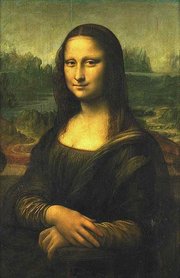Painting
|
|
Painting is the practice of applying pigment suspended in a carrier (or medium) and a binding agent (a glue) to a surface (support) such as paper, canvas or a wall. This is done by a painter; this term is used especially if this is his or her profession. Evidence indicates that humans have been painting for about 6 times as long as they have been using written language. Artistic painting is considered by many to be among the most important of the art forms.
Drawing, by comparison, is the process of making marks on a surface by applying pressure from or moving a tool on the surface.
| Contents |
History of painting
The oldest known paintings are at the Grotte Chauvet in France, dated at about 32,000 years old. They are engraved and painted using red ochre and black pigment and show horses, rhinoceros, lions, buffalo, and mammoth. There are examples of cave painting all over the world.
See also Art history.
Painting techniques
Painting techniques include:
- Impasto
- Wash
- Glaze
- Grisaille
- Pointillism (aka divisionism, 'stippling')
- Sfumato
- Sumi-e
- New materials (painting)
- Computer painting (Digital)
Painting supports
Painting media
Artists_paints.jpg
Examples include:
- Oil
- Water miscible oil paints
- Heat-set oils
- Acrylic
- Gouache
- Ink
- Pastel, including dry pastels, oil pastels, and pastel pencils
- Tempera
- Encaustic (wax)
- Watercolor
- Fresco
- Spray paint (Graffiti)
Popular painting styles
'Style' is used in two senses: It can refer to the distinctive visual elements, techniques and methods that typify an individual artist's work. It can also refer to the movement or school that an artist is associated with. This can stem from an actual group that the artist was consciously involved with or it can be a category in which art historians have placed the painter. The word 'style' in the latter sense has fallen out of favour in academic discussions about contemporary painting, though it continues to be used in popular contexts.
- Mannerism
- Baroque
- Neo-classicism
- Romanticism
- Realism
- Impressionism
- Pointillism
- Cubism
- Socialist Realism
- Fauvism
- Modernism
- Surrealism
- Abstract
- Constructivism
- Graffiti
- Pop-Art
- Postmodernism
Common painting idioms
Painting idioms include:
- Allegory
- Bodegon
- Botanical
- Figure painting
- Illustration
- Industrial
- Landscape
- Portrait
- Still life
- War
A proposed and yet-unrealised development in painting is four dimensional painting.
List of painters
Here is a growing list of painters too big for this page, see also Category:Painters.
Shortcuts to highly popular painters:
- Paul C麡nne, (1839-1906), French artist
- [[Salvador Dal흝, (1904-1989), Catalan artist
- Vincent van Gogh (1853-1890)
- Michelangelo Buonarroti, (1475-1564), Italian sculptor and painter
- Amedeo Modigliani, (1884-1920), Italian sculptor and painter
- Claude Monet, (1840-1926), French impressionist painter
- Pablo Picasso, (1881-1973), Spanish cubist artist
- Jackson Pollock, (1912-1956), US abstract expressionist painter
- Rembrandt, (1606-1669), Dutch painter
- Pierre-Auguste Renoir, (1841-1919), French impressionist painter
- Peter Paul Rubens, (1577-1640), Belgian painter
- Leonardo da Vinci, (1452-1519), Italian painter, sculptor and inventor

